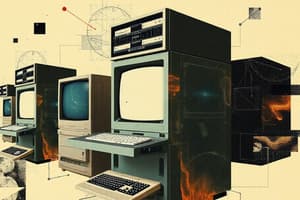Podcast
Questions and Answers
Supercomputers are solely utilized for meteorological and climate research applications.
Supercomputers are solely utilized for meteorological and climate research applications.
False (B)
Mainframe computers are designed to handle small datasets and support limited concurrent users.
Mainframe computers are designed to handle small datasets and support limited concurrent users.
False (B)
The processing power and computational capabilities of supercomputers are unrivaled, making them the most advanced computers worldwide.
The processing power and computational capabilities of supercomputers are unrivaled, making them the most advanced computers worldwide.
True (A)
The term 'big iron' is commonly used to refer to microcomputers due to their compact size.
The term 'big iron' is commonly used to refer to microcomputers due to their compact size.
Minicomputers and microcomputers are not mentioned or described in the given text.
Minicomputers and microcomputers are not mentioned or described in the given text.
Mainframe computers are primarily used by small businesses and individuals for personal computing needs.
Mainframe computers are primarily used by small businesses and individuals for personal computing needs.
Minicomputers are designed to support a smaller number of users than mainframes and more than microcomputers.
Minicomputers are designed to support a smaller number of users than mainframes and more than microcomputers.
Microcomputers, or personal computers (PCs), are typically composed of a single μ-processor, memory, and I/O circuitry on a single printed circuit board.
Microcomputers, or personal computers (PCs), are typically composed of a single μ-processor, memory, and I/O circuitry on a single printed circuit board.
Supercomputers are primarily used for personal computing tasks, such as web browsing and document editing.
Supercomputers are primarily used for personal computing tasks, such as web browsing and document editing.
Minicomputers are more cost-effective alternatives for smaller businesses and labs compared to mainframe computers.
Minicomputers are more cost-effective alternatives for smaller businesses and labs compared to mainframe computers.
Study Notes
Classification of Computers: Understanding Supercomputers, Mainframe Computers, Minicomputers, and Microcomputers
Computers can be classified based on various factors, including their size, processing power, and intended usage. One of the primary methods of classification involves categorizing computers based on their size, leading to four main categories: supercomputers, mainframe computers, minicomputers, and microcomputers. This article will delve deeper into each of these categories, providing insights into their unique characteristics and applications.
Supercomputers
Supercomputers represent the pinnacle of computational power and are typically utilized for scientific, engineering, and other computationally demanding applications. Supercomputers often rank among the fastest and most advanced computers worldwide, enabling complex calculations and simulations in fields such as physics, chemistry, meteorology, and engineering. Notable examples of supercomputers include those used for quantum mechanics, weather forecasting, climate research, oil and gas exploration, molecular modeling, and physical simulations.
Mainframe Computers
Mainframe computers, also known as 'big iron,' are characteristically large and expensive systems designed for enterprise-level data processing. They are particularly suitable for handling massive datasets and support multiple users simultaneously. Mainframe computers are commonly used by large corporations and government entities for managing critical operations, such as financial transactions, customer relationship management, and logistics.
Minicomputers
Minicomputers, also referred to as mid-range computers, fall between mainframes and microcomputers in terms of size and capabilities. They are designed to support a smaller number of users than mainframes but more than microcomputers. Minicomputers have been used for various applications, including control systems, instrumentation, human interaction, communication switching, as well as personal uses with the evolution of technology.
Microcomputers (Personal Computers)
Microcomputers, commonly known as personal computers (PCs), are intended for individual use and are widely available due to their affordability and versatility. These computers typically include a microprocessor, memory, I/O circuitry mounted on a single printed circuit board, making them compact and portable. PCs dominate various aspects of modern life, from home computing and entertainment to business productivity and education.
In conclusion, understanding different classifications of computers like supercomputers, mainframe computers, minicomputers, and microcomputers is crucial for selecting appropriate hardware solutions based on specific needs and requirements. Supercomputers offer unparalleled processing power for scientific research and engineering projects, while mainframe computers excel in enterprise-level data management and high-user environments. Minicomputers serve as cost-effective alternatives for smaller businesses and labs, and microcomputers provide everyday computing solutions for individuals. By recognizing these classifications, users can make informed decisions about their technology choices.
Studying That Suits You
Use AI to generate personalized quizzes and flashcards to suit your learning preferences.
Description
Explore the different categories of computers including supercomputers, mainframe computers, minicomputers, and microcomputers. Learn about their unique characteristics, applications, and how they cater to various computing needs.




